Good for a Girl
This essay was partly written during a November 2015 residency at the Luminary in Saint Louis, Missouri.
Women in Music
Thursday, November 19, 2015
The Luminary, Saint Louis, MO
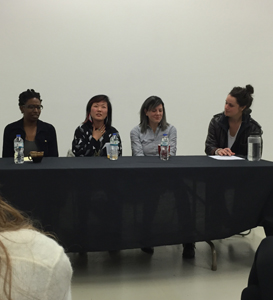
April Fulstone (second from left) describes her experiences with sexism in the DJ world (photograph by Christopher Howard)
How do you deal with sexism in the music industry, personally and professionally? This question from Liz Deichmann, operations and event coordinator at the Luminary, came halfway through the panel “Women in Music.” April Fulstone, known professionally as DJ Agile One, said that her experiences spinning records for fifteen years, specializing for a while in hip hop, have been plagued by “unintentional” sexism, such as comments about her ability to transport two Technics 1200 turntables, which weigh fifty pounds each with a case, by herself. At one venue, an older man was impressed that she was able to set up her equipment on her own.
Syhrea Conaway, a black multi-instrumentalist who works under the name Syna So Pro, cannot separate sex and race: a white woman or black man is less likely to experience what she has. A case in point: after playing with a bluesy band at Ten Mile House, a man remarked to her, “You know what? When you first walked in here, I was like, ‘What’s this black bitch doing here?’ But now that I’ve seen you play, I respect you.” At a venue, she regularly needs to assert that she is actually in the band, that she isn’t the merch girl, and that she isn’t loading in equipment to get free admission to the show. Conaway acknowledged that she will always be “questioned by my mere presence.” The most devalued compliment of all, she said, is being told “you’re good for a girl.”
Laura Sisal, a partner in the Ready Room, a mid-sized concert venue that can accommodate up to 750 people, must regularly persuade touring bands to accept her authority. “It’s extra pressure on you,” she said. “Do I bite my tongue or do I decide to fight this battle?” Often it’s a lose-lose situation when she stands up for herself—but why should she even have to? Christine Sanley, director of AAA radio promotion for co-sign, an artist-development agency for radio promotion, licensing, marketing, and brand strategy, is regularly asked “What does your boss think?” when she presents her company’s final decisions to others.
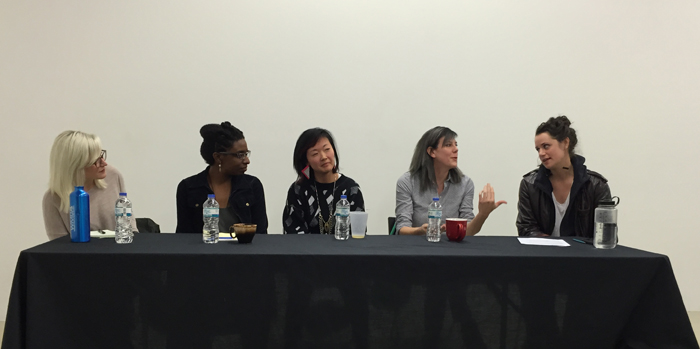
Five successful women in music, from left to right: Christine Sanley, Syhrea Conaway, April Fulstone, Laura Sisal, and Liz Deichmann (photograph by Christopher Howard)
Deichmann stated that “Women in Music” was held in response to “The Future of Music,” a discussion that took place at the Luminary in February 2015. Like that event, “Women in Music” had a local focus on the Saint Louis scene, yet the five panelists—all women, unlike the earlier, all-male event—shared personal anecdotes and experiences that, for better and worse, many across the country can relate to. Deichmann, who is also a musician and a promoter for Secret Sound Society and St. Louis Arts Project, began the conversation by asking how each woman first got involved with music and about their professional role models. Her questions, while job interview-y at times, garnered interesting and diverse responses.
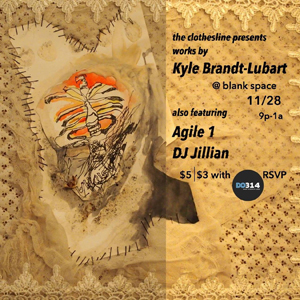
Promotional flyer for a Clothesline event
A former DJ at Washington University, Sanley came from the Omaha suburbs and entered the music scene surrounding the band Cursive and the record label Saddle Creek. Conaway began playing music at age seven, breaking free from her classical training at age twenty. Her mother played violin, which she took up herself, along with guitar, bass, keyboards, and now drums. A formative experience for her was watching TLC’s video for “Baby-Baby-Baby.” An Iowa City misfit, Fulstone lived for a while in Detroit and now runs a monthly party in Saint Louis called the Clothesline. A child of the 1990s, she admired Björk, Kim Gordon, Courtney Love, and Lauren Hill, and later M.I.A. “I love unique women who have cross-cultural sounds and backgrounds,” said Fulstone, who is Asian. Sisal has played in bands (organ, piano, guitar), worked for music labels, and studied audio production.1 Her peers include radio professionals, publicists, and entertainment lawyers. A foundational moment for her was watching the music video for No Doubt’s “Don’t Speak,” in which the singer Gwen Stefani looked feminine, tough, and beautiful all at once. Sisal also respects Sade for dropping in and out of the music business whenever she wants.
What are your biggest successes and challenges? As a kid Conaway performed at Carnegie Hall twice as a choir member—she is an incredibly gifted vocalist. Another highlight happened earlier this year, when four members of the contemporary chamber ensemble Alarm Will Sound performed as her backing band at the Sheldon Concert Hall in Saint Louis. Conaway claimed to be bad at promotion and social media, but her Facebook page looks up to date. Marketing is the fake version of you, Fulstone said. “I’m bad at being fake,” she added, noting that some music promoters actually want fakeness and femininity.
Sanley doubted she can eclipse facilitating a collaboration between Boy George and the Black Lips—they covered T. Rex’s “Bang a Gong.” Her biggest challenge, going from college radio to AAA, has been talking on the phone to old white dudes, persuading them to change their programming. Mainstream radio, Sanley noted, plays about 30 percent music by female recording artists. I wondered how changes in music business—such as corporate media consolidation, the collapse of the record industry, and the decline of radio in favor of satellite transmission and digital streaming—have changed gender relations in the industry.
Sisal, a self-described overachiever and perfectionist, pronounced that opening a concert venue—something she has wanted to do since seventh grade—was both an accomplishment and a challenge, especially for someone lacking an academic business or management background. “You don’t really have any type of instruction manual as to how to do this,” Sisal pointed out. Be patient and go with the flow, this Zen master advised. “If my thirteen-year-old self could see me now, she’d be freaking out.”
Do the panelists self-identify as an artist or as a woman artist? “People are interested, a little more, if you’re a woman,” Fulstone responded. Conaway said the press perpetually touts her as a “one-woman musical enigma,” sends up the notion of a one-man band. “You want to be faceless, so to speak,” Sisal insisted. “You just want the music to do the talking for you.” But appearances matter. She explained two paths to success for female performers: “There are certain artists that are fighting hard to be recognized as an artist, not a woman artist. And then there’s other people taking the approach of ‘I want to use my sexuality to get noticed and then once I’m famous, once I have your attention, I’ll let you know who I really am.’” Sisal finds that approach to be counterintuitive—it doesn’t have to be this way.
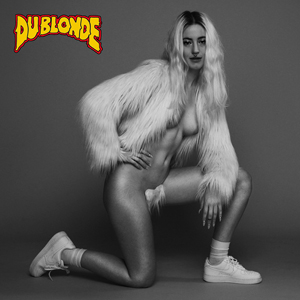 Conaway believes that “to slut it up a little bit” is a larger media problem that spills over into academic, athletic, and political life, where women’s achievements aren’t recognized or valued. Sanley argued that it’s transparent when a woman pimps herself, citing Du Blonde’s record cover for Welcome Back to Milk: “This woman, she’s like ‘Hey, it’s me with this banging merkin, and this really rad full coat.’” Du Blonde gets discredited, Sanley explained, for “doing her thing and embodying herself and being comfortable in her own skin.”2 Responding to Sisal’s comments, Sanley said, “It’s a clear line between someone going through the machine and getting oversexualized, and someone else just trying to take hold of their own body and sexuality and getting called out for it in a different way.” Look at Nicki Minaj, Fulstone quipped, “that’s what you have to do to be successful.” She also noted that fans of hip hop must often overlook a performer’s misogyny because of his talent. As a contrast, near the panel’s conclusion Deichmann recalled that she dressed masculine or androgynous on her band’s show days to make it easier to carry equipment, climb ladders, and kick stage divers off the stage.
Conaway believes that “to slut it up a little bit” is a larger media problem that spills over into academic, athletic, and political life, where women’s achievements aren’t recognized or valued. Sanley argued that it’s transparent when a woman pimps herself, citing Du Blonde’s record cover for Welcome Back to Milk: “This woman, she’s like ‘Hey, it’s me with this banging merkin, and this really rad full coat.’” Du Blonde gets discredited, Sanley explained, for “doing her thing and embodying herself and being comfortable in her own skin.”2 Responding to Sisal’s comments, Sanley said, “It’s a clear line between someone going through the machine and getting oversexualized, and someone else just trying to take hold of their own body and sexuality and getting called out for it in a different way.” Look at Nicki Minaj, Fulstone quipped, “that’s what you have to do to be successful.” She also noted that fans of hip hop must often overlook a performer’s misogyny because of his talent. As a contrast, near the panel’s conclusion Deichmann recalled that she dressed masculine or androgynous on her band’s show days to make it easier to carry equipment, climb ladders, and kick stage divers off the stage.
How does Saint Louis compare to other cities? New York is a competitive hustle no matter what sex you are, Sanley recalled of her three years there. On returning to Saint Louis, she expected to find a tighter-knit community of women but didn’t. In New York, she felt more connected to the scene, less so here—though she recognized that her job in radio has a national scope. Conaway bemoaned that indie rock is the only supported genre in town, especially by publications, at the expense of hip hop and R&B. Band ethics usually dictate that no performer leaves until everyone has played, she added, yet groups in Saint Louis don’t support the whole bill like they do in other cities. Fulstone found a strong scene in Detroit, where the music comes first, but in Saint Louis, it’s who you know. The racially segregated city is also a problem, she said. Sisal recalled that, in 2006 and 2007, you’d see members of other bands in your audience. They’re not there now. This may have to do with aging, the ebbs and flows of the scene, or both.
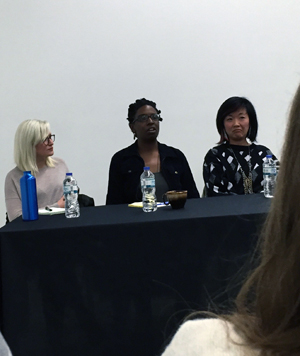
Syhrea Conway (center) prefers to support musicians on their merit, not their sex (photograph by Christopher Howard)
Any mentoring advice? Sanley advised, “Don’t be afraid, make connections, reach out to people, and support each other.” Emphasizing hard work, Conaway advocated setting goals and being honest with yourself and why you’re doing this. The panelists agreed that programming kids differently—with toys, for example—will help reduce sexism and change the music industry in twenty to thirty years. Deichmann acknowledged the power in collective action and support and, on a personal note, realized that tonight was the first time she and Sanley had talked about these issues, despite being longtime friends.
A male audience member noticed an increasing female presence in the noise, punk, and loud music scenes, identifying Savages, Melt Banana, and Pharmakon as examples. Sanley agreed but pointed out that a member of Perfect Pussy was ridiculed for writing a tour diary for Vogue—for some it’s not acceptable to be a badass punk interested in fashion and feminine things. Meredith Graves of that band wrote a tour diary for Elle in 2014, but maybe Sanley was referring to the “Thrift Diaries” that Emily Panic of Foxygen wrote for Jezebel. Progress is being made, she concluded, but there’s a long way to go—especially when she relayed a story about how an unnamed band’s management dropped an all-female four-person group after replacing two members with men. Fulstone proclaimed that seeing women in power positions in venues, as organizers of programming, demonstrates significant progress and a positive model for younger people.
The contentious discussion of artist and woman artist resurfaced. Conaway brought up the quality argument often heard from men: “You’re not really that good at what you do, but you are getting a lot of support because you are a woman. That’s not okay with me. How about you support a person on the merit of what they’re doing?” Conaway opposed using sexuality to compensate for the lack of talent.3 From the audience, the artist (and former Luminary resident) Tori Abernathy found the staunch agreement of being an artist (and not a woman artist) to be surprising. If gender is removed from the narrative, she argued, history gets rewritten with men being in charge. Women should get documented and make history their own. Putting that aside, Abernathy was curious about how women communicate their strengths, such as the leeway (white) women have when dealing with police and fire marshals—using prejudice to their advantage. Sisal proposed empathy and compassion. Sanley noted that a person’s sex is more intrinsically related to music than to art: an artwork or style can more easily defy gender stereotypes, while a woman onstage or heard on a record cannot.
In Terms Of count: 0.
1 Laura Sisal and Syhrea Conaway played together in Stella Mara, a shoegaze-inspired band, in the late 2000s.
2 Beth Jeans Houghton, who performs as Du Blonde, discussed the cover in Rachel Brodsky, “Du Blonde Pushes Dirt under Her Nails on ‘Welcome Back to Milk’,” Spin, May 12, 2015.
3 April Fulstone said something similar about her DJ career a few years ago: “‘I think it was a big novelty,’ she says. ‘People were really pushing me to take gigs, even before I was ready. They really wanted to see a girl out there. But it was important for me to be respected for my skill and not thrown in there because I’m a female.’” See Kevin C. Johnson, “St. Louis Women in Hip-Hop Struggle to Break Through,” Saint Louis Post-Dispatch, July 26, 2012.
Read
Natasha Patel, “Gender Inequality in the Music Industry,” Music Business Journal 11, no. 4 (October 2015): 1, 3.
Taylor Pittman, “This Is the Kind of Bullsh*t You Face as a Woman in the Music Industry,” Huffpost Women, August 27, 2015.
Dianca Potts, “DJing while Female in NYC: ‘I Can’t Believe You’re a Chick…’,” Village Voice, October 8, 2015.
Lindsay Zoladz, “Not Every Girl Is a Riot Grrrl,” Pitchfork, November 16, 2011.



